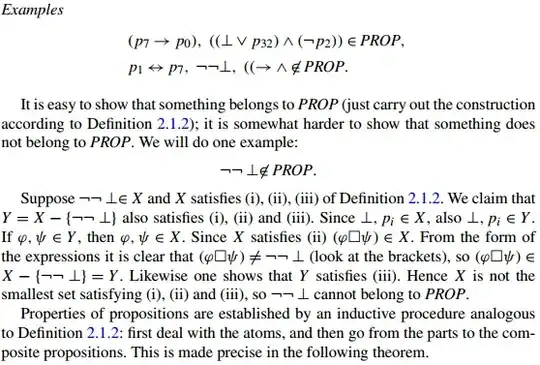I'm reading Dalen's Logic and Structure.
He gives the definition of the set $PROP$:
Definition $\bf2.1.2$ The set $PROP$ of propositions is the smallest set $X$ with the properties
$\begin{array}{rl} \rm(i)&p_i\in X(i\in N),\bot\in X,\\ \rm(ii)&\varphi,\psi\in X\Rightarrow(\varphi\wedge\psi),(\varphi\vee\psi),(\varphi\to\psi),(\varphi\leftrightarrow\psi)\in X,\\ \rm(iii)&\varphi\in X\Rightarrow(\neg\varphi)\in X.\\ \end{array}$
Then there are some examples:
And he says that $¬¬\bot \not\in PROP$, but I don't understand it. Isn't $¬¬ \bot=\bot$ due to the property of double negation? Considering this is true, $\bot\in PROP$. Of course, in this question, I'm pressuposing some kind of evaluation, that $¬¬ \bot$ becomes $\bot$ due to the law of the double negation, but perhaps it should be hold in an unevaluated form.
Ex:. $1+1=2$ because we presupose the $1$ merges with $1$ and then becomes two. If the merge (evaluation) does not happen, then I guess:
$$1+1=1+1$$ $$2=2$$ $$2\neq 1+1$$ $$1+1\neq 2$$
Perhaps it's something like that, I took the idea from Mathematica. Sometimes it does treats things as different in the absence of full evaluation.
